Liu Jianhua, Peng Wei at Plumblossom
by Gordon Fitch
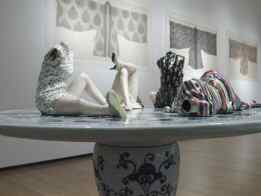
Installation table and wall display
(Click on picture for larger image)
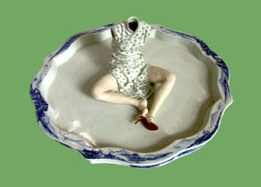
Liu Jianhua
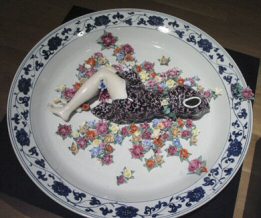
Liu Jianhua
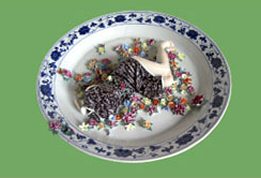
Liu Jianhua
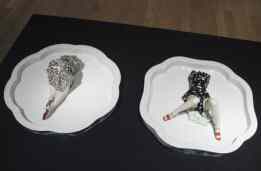
Installation Dish
(Click on picture for larger image)
This was a remarkable installation of two remarkable artists, both notable in their own right, which yet reflect and amplify one another's work in concert. Peng Wei's work consists of paintings of traditional Chinese garments which are restrained, flat, subtle and meticulous in the best traditions of Modernism; Liu Jianhua's work, by contrast, while also certainly showing a very high degree of skill and discipline, recalls the pretty porcelain sculpture of other eras -- we in the West would think of the Baroque period -- while presenting jarringly post-modern subject matter in the form of shapely young women's bodies which happen to lack heads and arms -- appendages which they don't seem to miss. The girls are served on large porcelain plates, sometimes one at a time, while others provide a numerous feast, disporting themselves in poses which are playful and sometimes plainly erotic (although they remain chastely if coquettishly dressed). One or two of them, not content with offering sexual possibilities, dump cornucopias of small objects out of themselves.
One might say that the paintings on the wall, as if ghostly ancestors or ancients of the community, stand around, enclose and bear witness to the sharp, sexy, headless porcelain girls writhing in their shiny solidity, perhaps the heights around a valley through which the porcelain stream of girls tumbles.
Both artists are commenting on the state of culture in contemporary, post-modern, "post-political" China, a China in which socialism and capitalism not only coexist but seem to be indistinguishable from one another. In the Revolutionary era, women were said to hold up half the sky, but now, like their sisters in the West, they need to come down to earth and scrabble for a living with the men and the machines, at the same time dealing with held-over misogynistic prejudices from the old days which have hardly disappeared, and the need as well to be an attractive, charming sexually desirable winner, incumbent on all the inhabitants of liberal capitalist societies -- in short, to be of service, to be served up, for fun and profit.
I was especially interested in the headlessness of the girls, because it reminded me of another artist, the late Baiyou Han , a number of whose paintings employ headlessness as a sign of loss of will, independent intellection, and self-respect. (See, for instance, "The Model of Fortune (The Richest Family In the Richest Country)" or "Surviving Model". While the trope of losing one's head is no doubt found world-wide, in both these cases we see a particular sharpness of satirical intent we don't, for instance, generally find in American uses of the metaphor. In the case of Liu Jianhua's work, the girls have not only lost their heads but their hands and arms as well, the symbols of competence and power. This doesn't keep them from posing seductively; perhaps it helps. One might say the same of the paintings of clothes which surround them: where have the bodies and souls of their wearers gone? Only a surface remains -- to challenge the viewer's own conceptions.
The textural or technical quality of both the paintings and the sculptures is of the very highest calibre, which, I think, makes them far more effective than they would be if a looser technique had been employed, and it also increases the attractiveness of the works merely as objects. But they are much more than objects; they speak.
Hopefully we will see these two artists again before too long.
 back to Contents page
back to Contents page